As with many emerging technologies, virtual reality advancements seem to be relevant at present only to serious gamers and hardcore tech enthusiasts. However, we can expect that as investments in the technology grow, and the necessary equipment becomes more stable and inexpensive, new applications will be developed that serve the needs of a more mainstream audience.
To continue reading, subscribe to Eco‑Business.
There's something for everyone. We offer a range of subscription plans.
- Access our stories and receive our Insights Weekly newsletter with the free EB Member plan.
- Unlock unlimited access to our content and archive with EB Circle.
- Publish your content with EB Premium.
VR has the potential to focus public attention on topics that are serious but are relatively inaccessible to laypeople, such as the importance of climate change and environmental degradation.
Despite the seeming accord among climate science experts about the need to combat global warming, many others lack an empathic, emotional connection to this subject.
It’s not easy for most people to think decades down the line and envision what our world will look like if pollution is left unchecked. Virtual reality simulations could bring home, in a visual, visceral way, the realities of the consequences of global warming.
Get your own VR headset
Although there are few headsets available for regular consumer use at present, there are several units in the works. Oculus Rift, purchased by Facebook last year, is perhaps the most well-known. Sony’s Project Morpheus, the HTC Vive, Samsung’s Gear VR and the Microsoft HoloLens are all expected to compete strongly in the emerging marketplace for consumer-grade virtual reality headsets.
VR tech has its roots in early attempts to create immersive environments for sensitive training situations, such as flight simulators, in the ‘70s and ‘80s. Technology advanced to the point that by the early ‘90s, there were several commercial attempts to create fully featured virtual reality products.
“
Researchers found that those who participated in the VR simulation went on to use 20 percent less paper during the rest of the day than those who merely read about the scenario.
However, display technology was not very mature back then, and processors were woefully underpowered. These problems led to flickering graphics, poor resolution and ultimately unsatisfying user experiences.
Inventors and investors largely abandoned the field until just a few years ago when an engineer named Palmer Luckey began working on the Oculus Rift. Using updated techniques and more powerful hardware, his prototypes showed the promise of actually fulfilling the hyped-up and over-enthusiastic predictions from several decades prior.
This kicked off the current scramble among hardware manufacturers to bring VR units to the masses.
We don’t need to wait for the future to see how virtual reality scenarios could impact environmental awareness; a few studies have already been done.
At Stanford University’s Virtual Human Interaction Lab, participants were given a headset to wear and asked to chop down a virtual tree. A separate group of people was asked to merely read a document about cutting down a tree.
Researchers found that those who participated in the VR simulation went on to use 20 percent less paper during the rest of the day than those who merely read about the scenario.
In another study, it was found that people who used virtual reality to explore the effects of acidification on a coral reef cared more about the possible ecosystem damage than those who merely watched a film about the same topic.
Through the use of such tools, we can show people the consequences of certain actions that would otherwise be invisible for many years.
We could also see changes in the way environmental news is reported. The Des Moines Register used the Oculus Rift to cover the history and transformation of a family farm. The story received more than 400,000 page views, which is much higher than the 30,000 that Executive Editor Amalie Nash says a “pretty good” traditional story would garner.
This is especially impressive when we consider that the Oculus Rift hasn’t yet been commercially released.
This new type of news, when paired with other new technology like fiber optic internet, could transform the way we get our news in the digital age. These technology innovations could highlight pollution, natural disasters and other types of environmental problems in a way that makes the viewer actually feel as though he or she were present at the scene of the incident.
Some may consider virtual reality to be just a diverting and inconsequential means of amusement, but it can truly become a powerful tool for environmental advocacy. From Rachel Carson’s Silent Spring to Al Gore’s An Inconvenient Truth, ecologically minded people have used a variety of forms of media to get their messages across over the years.
There’s little doubt that as VR becomes an everyday part of normal life, it will be a potent instrument in the hands of those who want to preserve our natural surroundings.
Emma Bailey is a writer in the greater Chicago area who covers technology, entertainment, and business. This article was written exclusively for Eco-Business.











